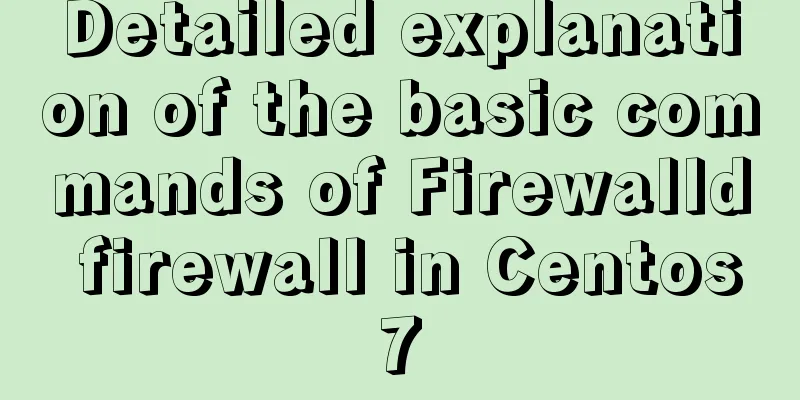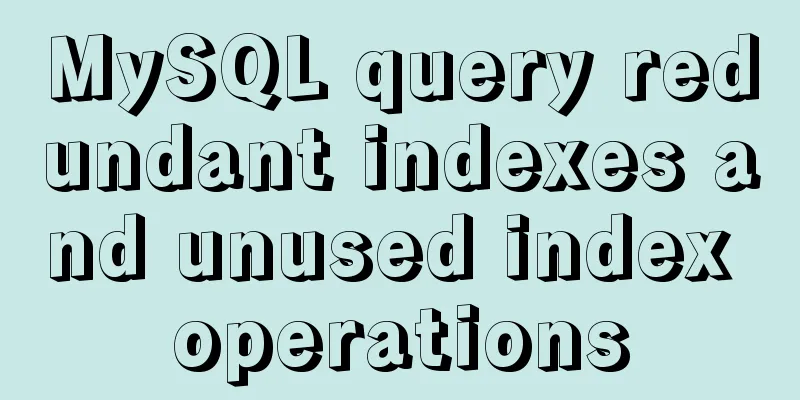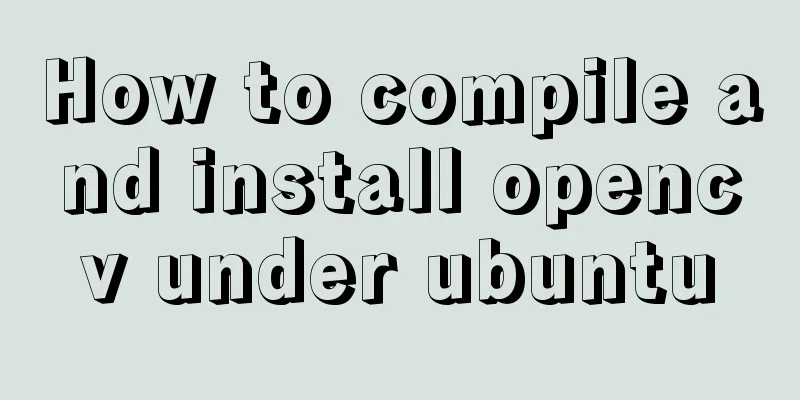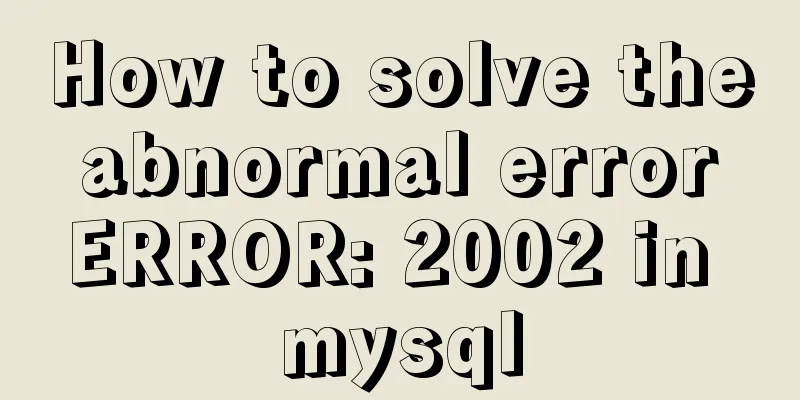Detailed explanation of the basic commands of Firewalld firewall in Centos7

|
1. Basics of Linux Firewall The Linux firewall system mainly works at the network layer, filtering and restricting TCP/IP data packets in real time. It is a typical packet filtering firewall (or network layer firewall). The firewall system of the Linux system is based on the coexistence of the kernel: firewalld, iptables, and ebtables. By default, firewalld is used to manage the netfilter subsystem.
1. Overview of firewalld The role of firewalld is to provide matching rules (or policies) for the packet filtering mechanism. Through various rules, it tells netfilter how to handle data packets coming from a specified source, going to a specified destination, or having certain protocol characteristics. In order to organize and manage firewalls more conveniently, firewalld provides dynamic firewall management tools that support network links and interface security levels defined by network zones. Supports IPv4, IPv6 firewall settings and Ethernet bridge, and has two configuration modes:
It also supports services or applications to directly add firewall rules interfaces. 2. Firewalld network area Firewalld divides all network data traffic into multiple zones, thus simplifying firewall management. Firewall rules that divert data traffic to the appropriate area based on conditions such as the source IP address of the data packet or the incoming network interface. For packets entering the system, the first thing to check is its source address:
The default zone is not a separate zone, but points to some other zone defined on the system. By default, the default zone is public, but this can be changed. The above matching rules are in order, and the first matching rule wins. In each area, you can configure a series of services or ports to be opened or closed. Each predefined area of firewalld is set with services that are opened by default. 3. Description of firewalld predefined areas
2. Configuration method of firewalld firewall In Centos 7 system, firewalld can be configured in three ways:
Generally, it is not recommended to edit the configuration file directly; 1. Basic commands of firewalld-cmd [root@centos01 ~]# systemctl start firewalld <!--Start firewalld--> [root@centos01 ~]# systemctl enable firewalld<!--Set firewalld to start automatically at boot--> [root@centos01 ~]# systemctl status firewalld <!--Check the running status of the firewall--> [root@localhost ~]# firewall-cmd --state <!-- View the firewall permission status --> running [root@centos01 ~]# systemctl stop firewalld<!--Stop firewalld--> [root@centos01 ~]# systemctl disable firewalld<!--Set firewalld not to start automatically at boot--> [root@centos01 ~]# firewall-cmd --get-zones <!--View the predefined areas of the firewall--> [root@centos01 ~]# firewall-cmd --get-service <!--View the predefined service types supported by the firewall--> [root@centos01 ~]# firewall-cmd --get-default-zone <!--View the default zone of the system--> [root@localhost /]# firewall-cmd --reload <!--Reload firewall--> [root@centos01 ~]# firewall-cmd --get-active-zones <!--View the activated areas--> [root@centos01 ~]# firewall-cmd --get-icmptypes <!--Display predefined ICMP types--> address-unreachable bad-header communication-prohibited destination-unreachable echo-reply echo-request fragmentation-needed host-precedence-violation host-prohibited host-redirect host-unknown host-unreachable ip-header-bad neighbour-advertisement neighbour-solicitation network-prohibited network-redirect network-unknown network-unreachable no-route packet-too-big parameter-problem port-unreachable precedence-cutoff protocol-unreachable redirect required-option-missing router-advertisement router-solicitation source-quench source-route-failed time-exceeded timestamp-reply timestamp-request tos-host-redirect tos-host-unreachable tos-network-redirect tos-network-unreachable ttl-zero-during-reassembly ttl-zero-during-transit unknown-header-type unknown-option The meanings of some blocking types in the firewall-cmd --get-icmptypes command execution results are as follows:
2. Firewalld zone management options
The following is an example of area management: [root@centos01 ~]# firewall-cmd --get-default-zone <!--Display the default zone in the current system--> [root@centos01 ~]# firewall-cmd --list-all<!--Display all rules of the default area--> [root@centos01 ~]# firewall-cmd --get-zone-of-interface=ens32 <!-- View the zone where the ens32 interface is located --> internal [root@centos01 ~]# firewall-cmd --zone=internal --change-interface=ens32 <!--Modify the area corresponding to the ens32 interface to the internal area--> The interface is under control of NetworkManager, setting zone to 'internal'. success [root@centos01 ~]# firewall-cmd --zone=internal --list-interface <!--View the interface list in the internal area--> ens32 [root@centos01 ~]# firewall-cmd --get-active-zones <!--Display all activated zones--> internal interfaces: ens32 3. Firewalld service management For ease of management, firewalld predefines many services, which are stored in the /usr/lib/firewalld/services/ directory. Services are specified through a single XML configuration file. These configuration files are named in the following format: service-name.xml. Each file corresponds to a specific network service, such as ssh service. We need to place the service configuration file in the /etc/firewalld/services/ directory. The service configuration has the following advantages: Managing rules by service name is more user-friendly; The mode of organizing port groups by service is more efficient. If a service uses several network ports, the service configuration file is equivalent to providing a batch operation shortcut for rule management of these ports. 1) Description of common options for service management in the firewalld-cmd command area:
2) The following is an example of firewalld service management (setting services allowed to be accessed for the default zone): [root@centos01 ~]# firewall-cmd --list-services <!--Display all services allowed to be accessed in the default area--> dhcpv6-client ssh [root@centos01 ~]# firewall-cmd --add-service=http <!--Set the default area to allow access to http service--> success [root@centos01 ~]# firewall-cmd --add-service=https <!--Set the default area to allow access to https service--> success [root@centos01 ~]# firewall-cmd --list-services <!--Display all services allowed to be accessed in the default area--> dhcpv6-client ssh https http 3) The following is an example of firewalld service management (setting services that are allowed to be accessed for the internal zone):
[root@centos01 ~]# firewall-cmd --zone=internal --add-service=mysql
<!--Set the internal area to allow access to the MySQL service-->
success
[root@centos01 ~]# firewall-cmd --zone=internal --remove-service=samba-client
<!--Set the internal area to not allow access to the Samba-client service-->
success
[root@centos01 ~]# firewall-cmd --zone=internal --list-services
<!--Show all services allowed to be accessed in the internal area-->
ssh mdns dhcpv6-client mysql
4. Port Management When configuring services, predefined network services can be configured using service names, and the ports involved in the services will be automatically opened. However, for non-predefined services, you can only manually add ports for the specified zone. For example, you can open port 443/TCP in the internal zone by performing the following operations: Here is an example:
[root@centos01 ~]# firewall-cmd --zone=internal --add-port=443/tcp
<!--Open port 443/tcp in the internal area-->
success
If you want to prohibit access to port 443/TCP in the internal zone, execute the following command:
[root@centos01 ~]# firewall-cmd --zone=internal --remove-port=443/tcp
<!--Prohibit access to port 443/tcp in the internal area-->
success
The above configurations are all temporary configurations. If you want to save the current configuration as a permanent configuration, you can use the following command: [root@centos01 ~]# firewall-cmd --runtime-to-permanent success To configure it as a permanent rule directly, you must include the --permanent option, as follows:
[root@centos01 ~]# firewall-cmd --add-icmp-block=echo-request --permanent <!--Prohibit ping-->
success
[root@centos01 ~]# firewall-cmd --zone=external --add-icmp-block=echo-request --permanent
<!--Configure external area to prohibit ping-->
success
3. Two configuration modes of firewalld As mentioned earlier, the firewall-cmd command tool has two configuration modes: Runtime mode refers to the firewall configuration currently running in memory, which will become invalid when the system or firewalld service is restarted or stopped; Permanent mode refers to the rule configuration when the firewall is restarted or reloaded, which is permanently stored in the configuration file. The firewall-cmd command tool has three options related to configuration mode:
The above is the full content of this article. I hope it will be helpful for everyone’s study. I also hope that everyone will support 123WORDPRESS.COM. You may also be interested in:
|
<<: MySQL 5.7.21 decompression version installation and configuration graphic tutorial
>>: Detailed explanation of the loading rules of the require method in node.js
Recommend
Element UI table realizes drop-down filtering function
This article example shares the specific code for...
MySQL calculates the number of days, months, and years between two dates
The MySQL built-in date function TIMESTAMPDIFF ca...
jQuery+swiper component realizes the timeline sliding year tab switching effect
Result: Implementation code: Need to be used with...
Detailed explanation of the usage of DECIMAL in MySQL data type
Detailed explanation of the usage of DECIMAL in M...
About uniApp editor WeChat sliding problem
The uniapp applet will have a similar drop-down p...
Steps of an excellent registration process
For a website, it is the most basic function. So l...
How to reference external CSS files and iconfont in WeChat applet wxss
cause The way to import external files into a min...
Detailed explanation of MySQL table name case-insensitive configuration method
By default, MySQL in Linux distinguishes between ...
A brief discussion on the implementation principle of Vue slot
Table of contents 1. Sample code 2. See the essen...
JS implements simple example code to control video playback speed
introduction I discovered a problem before: somet...
jQuery realizes the shuttle box effect
This article example shares the specific code of ...
How to use CSS to pull down a small image to view a large image and information
Today I will talk about a CSS special effect of h...
Linux solves the problem that Deepin cannot start Google Chrome browser as root user
To solve the problem that Deepin cannot start Goo...
How to calculate the value of ken_len in MySQL query plan
The meaning of key_len In MySQL, you can use expl...









